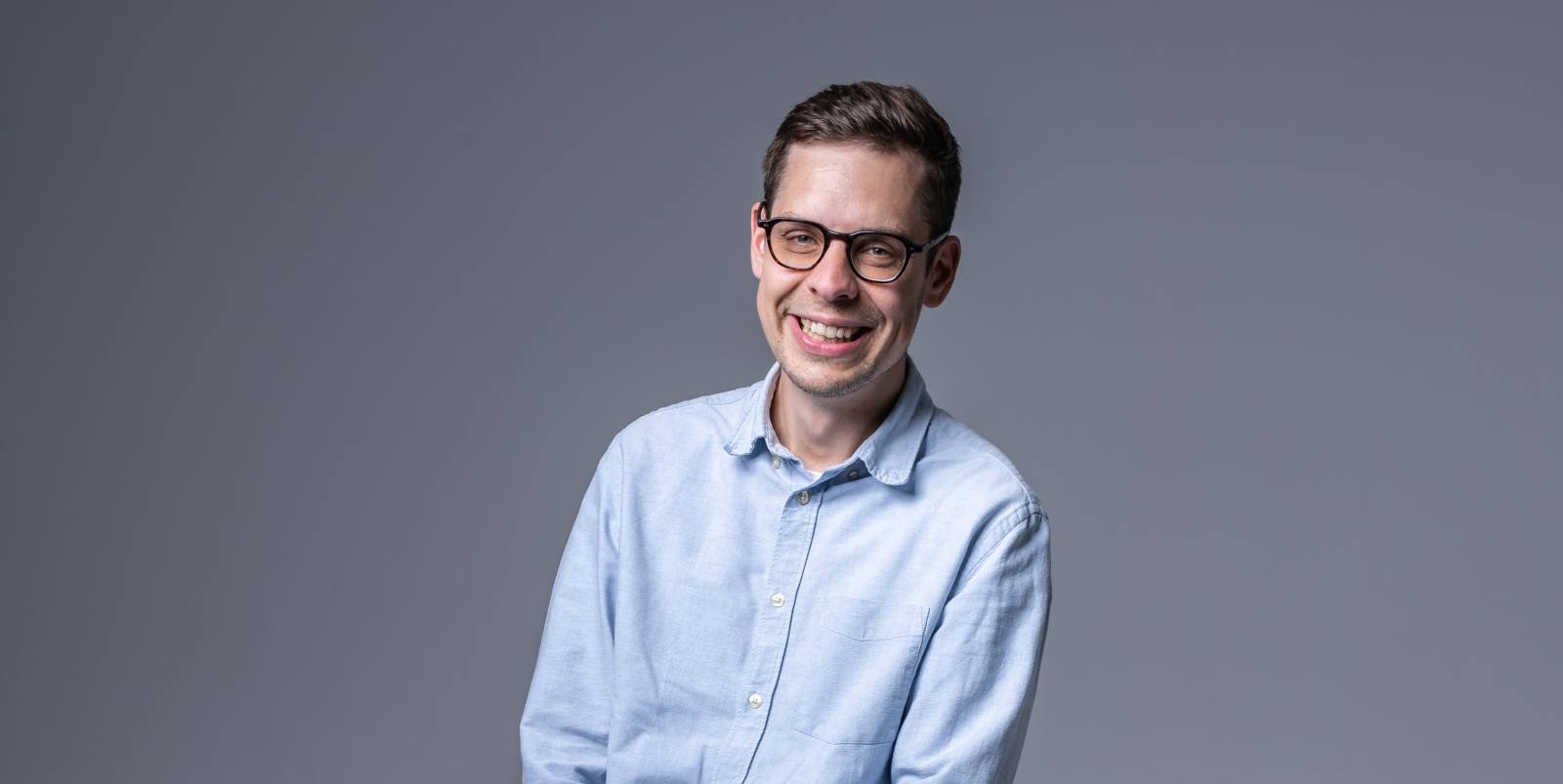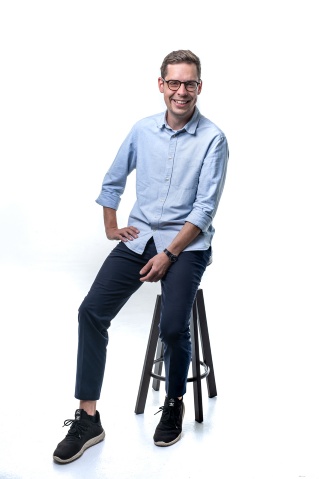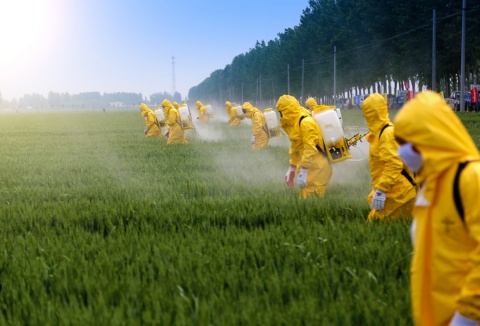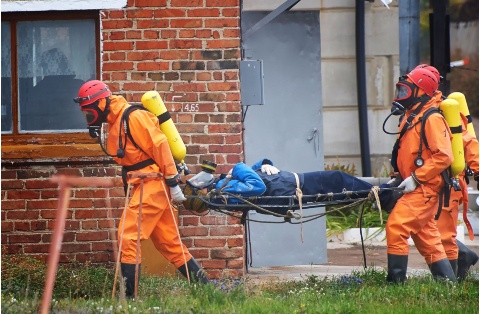
Chemistry must protect our environment, says Otto Wichterle Award winner
28. 07. 2022
Scientists can find and isolate dozens of foreign substances in a single glass of water. The concentration of each of them is minimal, but the problem is that water contains such a variety of them in the first place. Environmental pollutants are substances that pollute our environment and can survive in nature for years or even decades. Jiří Henych from the Institute of Inorganic Chemistry of the CAS has developed a nanocomposite which neutralises such pollutants and works on synthetic warfare agents in addition to pesticides. Read our interview with him below.
You are working on nanostructured metal oxides. What should one imagine under this term?
Nanomaterials have always been here with us – take, for instance, nanoparticles produced by combustion or activated carbon. The crux of my field is the fact that at the microscopic level, let’s say below 100 nanometers, the properties of certain substances change and behave differently from how we are normally used to seeing on the macro level. Metal oxides as such, in the form of powdered materials, are made up of tiny nanocrystals. These have a large surface area which contain active zones where interesting physical and chemical processes can occur.
One of these is adsorption, whereby the oxides can bind a number of other substances to their surface and then reactively transform them. Such properties of materials can be utilised in various industries. We focused on one small segment of possible applications: environmental chemistry, which is what interests me the most.
That sounds like a fairly specialised focus. How did you get into it?
The research is actually very multidisciplinary. You are right that it comprises a specific discipline, but it’s one that requires knowledge of ecology and organic, inorganic, and analytical chemistry. Our long-term focus has been on research into how to break down pesticides and other pollutants in the environment. One advantage of our research is that the findings of environmental chemistry are highly applicable. I think this is the branch of chemistry that will be of greatest interest to us as a society in the coming future.
So how is your research going?
We are constantly preparing and developing new materials that have the potential of being effective for the disposal of harmful substances found in our environment. At the same time, we are expanding the portfolio of substances whose impact on nature we are studying. In addition to pesticides, these include pharmaceuticals, and we are also studying aquatic micropollutants that have pharmacological origin.
Do pharmaceuticals get into the water?
Yes, and not only those. Micropollutants include substances that have been in the water for a long time. It’s not that our water treatment technologies don’t work; these are substances in such small concentrations that they cannot be easily removed. Today we know they are present in the water, but earlier analytical methods couldn’t detect them. For example, trace amounts of caffeine can be found in almost every glass of tap water.
How dangerous are these substances?
On their own, they wouldn’t have to be of any concern to us, because in such small concentrations, they should have no significant biological impact on our health. While the concentration of some of them meets legal limits, there are no such limits imposed yet for other substances. The problem is that there is a huge variety of these substances to be found in the water. We can find everything from pesticides, nanomaterials, and microplastics to pharmaceutical residue, from the latter of which there is, for example, the ubiquitous ibuprofen, antidepressants, and various hormones. And all of these together are the disturbing part. We have no idea what kind of biological effects many of them may have. Acute toxicity is easy to detect, but long-term effects aren’t.

Jiří Henych from the Institute of Inorganic Chemistry of the CAS (CC)
Shouldn’t we stop using them then?
Easier said than done. It’s true that in ecology, a kind of precautionary system applies: if you’re not exactly sure what effects a substance has, it’s better not to release it into nature. But in this case we’re talking about substances that are either already present in our environment or that we as a society need to use. Take, for example, bisphenols, which are plasticisers. We know from research that the massively widespread bisphenol A (BPA) is an endocrine disruptor and, in certain concentrations, can damage the hormonal system. And so its use is being phased out. Instead, it’s being replaced by other bisphenols. But now it turns out that some of them are equally as detrimental.
Are there a lot of such substances with their effects unresearched in use?
Yes, but it’s not that they’re unresearched. It’s just very difficult to determine how they will behave in the environment over a long period of time. A well-known example is DDT. Only after time was it discovered that it remains in the environment for many years and has negative effects. It was replaced by organophosphorus pesticides. But these are toxic on contact and act like nerve agents on the body. It appears that even the residue of some of them remain in the environment long after they have been applied. It is evident that we cannot manage without certain chemicals and that their use is desirable. They improve our quality of life. However, human society produces a relatively large number of these new substances and it is quite complicated to detect all their effects on all aspects of the environment.
And this is where the results of your research find application?
Yes. Since the use of such chemicals is inevitable, it is also good to have the technology to monitor (and curb) them. We are therefore interested in whether and how new materials that were originally developed, for instance, to destroy chemical warfare agents, could be used to eliminate these pollutants from the environment.
With colleagues from the Institute of Physics of the CAS and others, you have developed a nanocomposite – a powdered substance that can destroy pesticides and nerve agents.
Yes, but that’s just one particular material of which we have synthesized many. Sure, it’s interesting, but we’re working on many more like it. The basis of the research was to test the effectiveness in the degradation of chemical warfare agents, which was done by colleagues from the Military Research Institute in Brno. We focused on testing the effect on pollutants present in the environment. Some of these pollutants are similar in structure to the chemical warfare agents. And it worked.
So you’ve found multiple uses. How exactly does your nanocomposite work?
All substances and materials around us adsorb something. Their molecules can bind to other molecules on their surface via physical bonding (called physisorption) – I’ve already mentioned activated carbon, which is used to purify water. In addition, the metal oxides our research focuses on have so-called active sites on their surfaces which, very simply put, either lack electrons or have an excess of them. They are therefore able to bind parts of other molecules. If a chemical bond is formed when a molecule interacts with an active site, this is called chemisorption. However, this bond is much stronger than that of physisorption, and so the system of the chemical bonds of the attached molecule can change and the molecule can break down – some of it splits off and some of it remains. As a result, the substance changes its properties completely, for instance, losing its toxicity. In addition, this less toxic substance remains attached to the oxide, so you can then filter it out or otherwise remove it relatively easily.

There’s an overlap in the historical development of pesticides and chemical warfare agents, which began to be produced on an industrial scale from the mid-1940s onwards and were supposed to guarantee higher agricultural yields.
There’s been a lot of talk about the effect of your nanocomposite on the Novichok nerve agent. They say it’s capable of neutralising it.
Novichok belongs to the group of organophosphates, but that in itself is a pretty broad family of substances with various properties. The chemical warfare agents among them include sarin, which is a volatile gas, or VX, which is a viscous liquid. And our product works differently on each of them. With Novichok, we can only assume the effects. That’s because we don’t know its exact chemical structure. Researchers at the Military Research Institute in Brno theoretically have the technology to prepare a microdose of Novichok, but they have no reason to, and they might not even know what it looks like. From the little we do know, there are some similarities. But at this point in time, we can’t discern how effective our nanocomposite would be against it, or how quickly it would work.
The results of our tests had come out at a time when Novichok was getting a lot of press. So all attention has been laser-focused on this hypothesis. I’ve always asked interviewers not to mention Novichok in the headline. Alas, it, of course, always popped up (laughter).
It’s a big discovery. How long does the research of a substance like that take?
It’s a lengthy process. The research on this type of oxides was already started by my supervisor, who noticed that thanks to their structure, they might be able to counteract chemical warfare agents. After synthesising them, the Military Research Institute got involved and developed a methodology for testing. Only later did it become apparent that the material could also be effective against pollutants. Through a long series of research experiments, we finally got to where we are now. The whole process took about twenty years. Of course, I have not been a part of it the whole time, only for the last eleven years or so.
Has your discovery garnered any response from other institutions and companies?
I must say that interest has been surprisingly high, especially from entities looking for alternatives to conventional decontamination materials. For instance, we’re currently working with the National Institute for Nuclear, Chemical and Biological Protection. In addition to their application in the military, these substances are also of interest to departments dealing with the decontamination of hazardous materials, like firefighters or rescue services. But safe decontamination is also needed elsewhere, for example, when illegal drug labs have to be decontaminated and cleaned out. We also work with companies which deal with oil spill response and water treatment. A number of foreign universities (in Sweden and France) have also expressed an interest in subsequent joint research. In short, we are trying to find the widest possible portfolio of applications for our substances. However, I must also add that technology transfer is a relatively new and unexplored discipline for us, and we are only now getting into it. All such cooperation is still therefore in the initial stages at the moment.
There’s a very wide range of possible applications.
And we haven’t even talked about bioapplications yet. In fact, some of the materials we are working with can mimic the function of enzymes in the human body. Cerium oxide, for instance, could theoretically be used to protect healthy cells or destroy cancer cells. It is thought that these oxides could act as a sort of artificial enzyme. And what’s more, some have been shown to have antiviral effects. There is a huge number of possible uses and we’re concentrating on just one small segment. And that’s what we want to be really good at.
You seem to be on the right track. Two years ago, you received the Otto Wichterle Award for your research, which the Czech Academy of Sciences awards to promising young scientists. How did you react to the award then?
I was delighted of course, there’s no denying that. But the way I see it is that such an award is never just about the individual. I have been involved in this research since my master’s thesis and I work with many people every day, who of course help me out. Moreover, the advancement of science has no beginning and no end. By that I mean: there have been decades of work by many eminent individuals, researchers, before me, whose findings I have built on. So I’ve just added another piece to the overall puzzle.

Last year, Science magazine published a study showing that the toxicity of synthetic pesticides to invertebrates and beneficial insects has doubled since 2005.
You say this with great humility.
To be honest, I did not even know that such an award existed. It wasn’t until the board of my institute told me that the results of our work were interesting enough to qualify for the award. So until that point, I hadn’t thought about it at all.
Did your colleagues congratulate you or were they silently envying you?
They congratulated me, of course. And I’m pretty sure they didn’t envy me. Some of my colleagues have experienced a similar journey as me, and they’re also mostly younger. They know what obstacles I’ve encountered in my career so far, they have similar problems, fears. They’ve also gone through similarly positive situations. They understand what it means when your superiors put their trust in you as a young researcher, giving you free rein. Plus, they’re just as good researchers as I am. In a few years, maybe some award or other will be bestowed upon them, too.
How did the award impact your professional life? Has it opened any previously closed doors?
A scientist’s results, not awards, should speak loudest for them. But I must admit that the award has been helpful. Our research found its way into the media, which led to researchers from other institutes contacting me. Furthermore, there is not that much money in science and the financial boost certainly helped. At the same time, it is a prestigious award, so it says something about the quality of the work itself. It proves to the public that we can be counted on. This indication has resonated in our small Czech scientific community. And I also admit that I was really happy to be able to add it to my CV.
Has the award helped your field as well?
To a certain extent. Attracting enough young people to research is a long-term challenge. Unfortunately, the natural sciences in general aren’t really seen as attractive enough. So when the Czech Academy of Sciences motivates young researchers in this way, it is only to the benefit of the cause. I myself am, shall we say, at the beginning of my career, and I personally find it an incentive to keep improving my research. It can serve as motivation for the advancement of the researchers themselves.
You’ve mentioned that many eminent researchers have worked in this field before you, and you have built on their work. Which giants are you standing on the shoulders of?
I studied at the Faculty of Environment of Jan Evangelista Purkyně University in Ústí nad Labem. Professor Pavel Janoš, who was the one to lead me to this path, still works there. When I had asked him during my studies if he could think of an interesting lab topic for my thesis, he took me with him to Řež. Here I met Václav Štengel from the Institute of Inorganic Chemistry of the CAS, who was working on materials chemistry. He is the father of this whole scientific endeavour. After our first conversation, it was clear to me that I had found what I wanted to do. But I approached it from a slightly different standpoint than he did. Rather than developing new materials, I was interested in their applications.
Was it really that spontaneous?
Yes, and besides that, I was mesmerised by the environment itself. The research facilities, the instruments, the nice laboratories... and above all the attractive research topics. While we aren’t that far from Prague, hosting a lot of students and future researchers, the only way to attract young people to Řež is to offer an attractive research topic. It’s I think easy to see that I still enjoy my work. I’ve been here for 11 years and counting.

The nanocomposite, which is capable of neutralising toxic substances in the environment, is used not only in ecology and the military, it is also well-suited for the fire department.
Well, I think you’re at a point where you can now sum up more than a decade of your work. In retrospect, did the Czech Academy of Sciences meet your expectations?
In the beginning, I didn’t know what to expect. I was more like a sponge, soaking up all the information about the possible forms of scientific work and how the Academy functioned. But yes, the experience met my expectations. I can say this mainly because this entire time I’ve been doing something I enjoy, something that is meaningful, from my point of view. A big part of that is the fact that my job allows me a great deal of freedom, which is something not everyone can say. From my current position, I can say that an excellent scientific environment is to be found at the Academy.
In addition to your research work at the Institute of Inorganic Chemistry of the CAS, you also teach at the Faculty of Environment and the Faculty of Science at Jan Evangelista Purkyně University in Ústí nad Labem. You are therefore active not only in research, but also in academia.
Yes, but of course, research is the priority. However, it is sometimes liberating to get out of the lab into an environment full of young people. I think that whoever is involved in research should also work in a university environment. It’s not right to teach the same things again and again according to the same formula; a researcher must update their knowledge and pass it on in the form of teaching. So I think of teaching as a duty, but it’s also quite fun.
From your point of view, does the link between the research and university environments work?
From my point of view I can say that it does, because we do manage to attract students here to Řež. Every year, several students work on their theses here or come for specialised training and internships. They come from all over the country, not only from Ústí nad Labem where I teach, and Prague, which is nearby, but also from Pardubice. New blood is needed in science and the Academy. The students are go-getters and frequently come up with innovative ideas.
You’re young, successful, and you can act as a role model for your students. What do they need to succeed?
Definitely perseverance. In my experience, most students and emerging researchers leave not because they aren’t skilled or knowledgeable enough, but because they can’t endure everything that comes with science. Sometimes you get disillusioned, other times research comes to a standstill, you struggle to find funding or support. There comes a time when you might ask yourself why you’re even doing this. But the answer is simple: because you are interested in science and want to do it. But it definitely helps if you find people around you who you can rely on, whether as a supervisor or fellow colleagues.
You’re a researcher, you’re a teacher, and you’re also a trainee supervisor. Do you still have any time for yourself?
Personally, I admire people who are able to put all their energy into their work. I like to go out for walks. Or I ride my bike, because Ústí nad Labem has beautiful surroundings. I like to talk to people, go out for a beer. It’s important to find balance in life. When you do, you’re able to look forward to work the next day.
How has your work changed during your time at the Czech Academy of Sciences?
Unfortunately, I’m spending less and less time in the lab. Instead, I task the lab work out to my colleagues in the team. I spend about a third of my time in front of the computer screen, writing papers, evaluating data, creating reports. Then I also establish collaborations. Eventually, if there’s any time left, I can sometimes get to the lab.
Where would you like to take your research next?
For me, environmental protection is an extremely important topic. I hope that in the future, our team will grow and we will develop a systematic methodology to study the substances that protect the environment. It would also be worthwhile to better explore applications in sectors that we currently have a marginal understand of. I am thinking, for example, of the already mentioned artificial enzymes. Of course, we are always interested in experimenting with and synthesising new types of substances. When you study the properties of materials on an atomic level and subsequently see how they translate into our macro world, it is simply incredible. I myself like to look for ways in which these microscopic properties can be put to practical use.
________________________________________
Ing. Jiří Henych, Ph.D.
Institute of Inorganic Chemistry of the CAS
He graduated from the Faculty of Environment at Jan Evangelista Purkyně University, majoring in environmental protection and waste management. He continued his studies in environmental analytical chemistry. He has not completely parted ways with his alma mater; today, he educates not only young researchers there, but also teachers and colleagues from his field. His focus is on researching new materials for the disposal of toxic substances such as organophosphorus chemical warfare agents and pesticides. He is the recipient of the 2020 Otto Wichterle Award.
Prepared by: Jan Hanáček, Division of External Relations, CAO of the CAS
Translated by: Tereza Novická, Division of External Relations, CAO of the CAS
Photo: Jana Plavec, Division of External Relations, CAO of the CAS; Shutterstock
 The text, banner photo and photos marked (CC) are released for use under the Creative Commons license.
The text, banner photo and photos marked (CC) are released for use under the Creative Commons license.
Read also
- A trapped state: The pandemic impact on public attitudes, trust, and behavior
- Aerial archaeology: Tracing the footsteps of our ancestors from the sky
- Archaeologists uncover ancient finds along Prague Ring Road
- Our microbiome largely depends on what we eat, says microbiologist Michal Kraus
- The ABCs of writing: Why did its invention mark a turning point for humankind?
- We learn, remember, forget… What can memory actually do? And can we outsmart it?
- New Center for Electron Microscopy in Brno opens its doors to global science
- The hidden lives of waste: What can we learn from waste workers and pickers?
- A unique lab is hidden right beneath Prague’s Vítkov Hill
- Renewables are a strategic investment in European security, scientists say
The Czech Academy of Sciences (the CAS)
The mission of the CAS
The primary mission of the CAS is to conduct research in a broad spectrum of natural, technical and social sciences as well as humanities. This research aims to advance progress of scientific knowledge at the international level, considering, however, the specific needs of the Czech society and the national culture.
President of the CAS
Prof. Eva Zažímalová has started her second term of office in May 2021. She is a respected scientist, and a Professor of Plant Anatomy and Physiology.
She is also a part of GCSA of the EU.